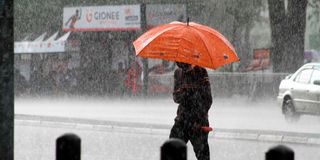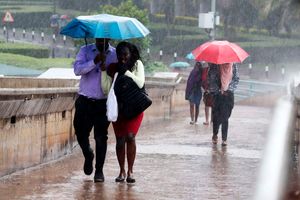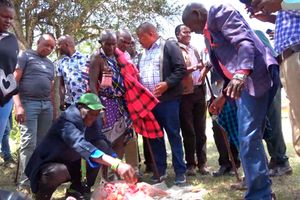New AI tool predicts rainfall more accurately and in a short time

A pedestrian shields himself from rain with an umbrella along Kenya Avenue in Nairobi. Scientists have come up with a new Artificial intelligence (AI) tool dubbed MetNet, which can now predict short-term rainfall forecasts with better precision.
What you need to know:
- The information is now available when users around the world search for weather data using their phones –save for areas that do not have Google weather forecast like South Korea.
If I were to write an open letter to our ancestors about the world today, I would tell them that we no longer need to step out and check the clouds or observe animal behaviour to know when it is about to rain.
A lot has changed, and it keeps changing.
I would be grateful for their traditional predictions, although they failed sometimes and we would step out on a seemingly sunny day only to be drenched in rainwater.
Annoying, wasn’t it?
This has inspired scientists to come up with a new Artificial intelligence (AI) tool dubbed MetNet, which can now predict short-term rainfall forecasts with better precision.
The tool was created through advancement in Google Research on the AI-powered Nowcasting model.
The scientists explain that it uses satellite data and ground observations to produce state-of-the-art precipitation forecasts in data-sparse regions of the world like Africa.
Their technology can predict global precipitation with high accuracy within a 5km radius every 15 minutes for the next 12 hours — all under one minute.
The scientists –Shreya Agrawal and Emmanuel Brempong - say in a statement that these short-term rainfall forecasts are being made available across Africa, for the first time.
“One critical component for weather forecasts is dense ground radar, which is not available for the majority of the world where billions of people live. The need for new approaches and better weather forecasts is especially pronounced in Africa, where ground observations are limited and global weather models tend to exhibit low skill,” they explain.
A study published in the scientific journal Weather Radar for Hydrological Modelling explains that weather radars are remote sensing equipment that are widely employed in the hydrological and meteorological communities for the estimation of rainfall on detailed information about small locations.
They explain that it was first developed for military use in the period before and during World War II.
“During the war, radar operators noticed echoes on radar screens caused by weather phenomena. After the war, scientists studied how to use radars for detecting rainfall. Since then, weather radars have been used by national weather services and research institutions since they enable the detection of precipitating clouds as well as their structure and development,” the study explains
Despite this discovery, it is still disproportionately used around the world. A World Meteorological Organization (WMO) database shows that Europe has about 345 radar facilities, North America has 291 while Africa has only 37 of those.
“Using AI and satellite observations, the model was able to fill in the gaps, even in areas where radar was unavailable, overcoming previous limitations in data sparse regions. It is also our first model to directly incorporate observations from a multitude of satellites,” said the Google scientists in a statement.
The information is now available when users around the world search for weather data using their phones –save for areas that do not have Google weather forecast like South Korea.
The start and end times of the rainfall are in the local time zone of the location you search for.
“We are excited to see this work leave our offices in Accra and Nairobi and make its way to users all across Africa. We are engaging with local scientific communities to further evaluate and improve forecast accuracy globally. We’re also looking to launch the technology in additional regions with limited radar,” said the scientists.
hshikanda@ke.nationmedia.com


